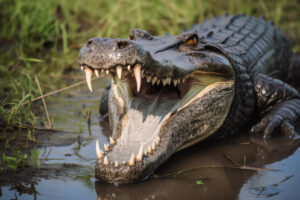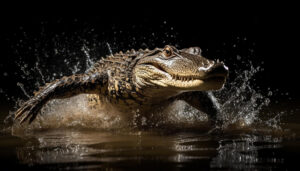Crocodiles, captivating creatures with a lineage dating back millions of years, have earned a reputation as ancient predators. This exploration delves into their intriguing world, unravelling the diversity of species, adaptive behaviours, and their critical role in maintaining ecological balance.
The Diversity of Crocodile Species – Facts

Real Crocodile Facts
- The order Crocodylia encompasses 14 distinct crocodile species, showcasing a remarkable range of adaptations and survival strategies across various environments.
- The saltwater crocodile (Crocodylus porosus), the largest living species, dominates coastal regions, with males exceeding 20 feet in length and weighing over 2,000 pounds.
- Nile crocodiles (Crocodylus niloticus) are adept hunters, employing a powerful “death roll” technique to subdue prey in aquatic environments, revealing the diversity of predatory tactics.
- The American crocodile (Crocodylus acutus), adaptable to both saltwater and freshwater habitats, thrives in coastal regions stretching from Florida to South America.
- Crocodiles, ectothermic reptiles, utilize basking behaviours to regulate body temperature, often seen sunning themselves on riverbanks for thermoregulation.
- The dwarf crocodile (Osteolaemus tetraspis), native to West African rainforests, represents the smallest crocodile species, adapting to unique habitats.
Crocodile’s Remarkable Behaviours and Adaptations

Crocodile Facts
- Despite their fearsome reputation, crocodiles exhibit attentive parenting behaviours, with mothers guarding nests and even carrying hatchlings in their mouths for protection.
- Vocalizations play a crucial role in crocodile communication, ranging from low-frequency roars to high-pitched chirps, facilitating social interactions within their communities.
- Crocodile eyes are uniquely adapted for their semi-aquatic lifestyle, featuring a nictitating membrane that shields their eyes underwater.
- The Gharial (Gavialis gangeticus), with its distinctive long and slender snout, is well-suited for catching fish, exemplifying the specialized adaptations of certain crocodile species.
- Crocodiles, as apex predators, contribute significantly to maintaining biodiversity by controlling prey populations, preventing overgrazing, and influencing the behaviour of other species.
- Estuarine crocodiles (Crocodylus porosus) undertake remarkable oceanic journeys, with individuals recorded traveling distances exceeding 600 miles, showcasing their migratory abilities.
Conservation Challenges and Ecological Significance

Crocodile Real Facts
- Crocodile farms, established for conservation and commercial purposes, contribute to preserving wild populations by reducing pressure on their habitats and supporting habitat conservation initiatives.
- The critically endangered Siamese crocodile (Crocodylus siamensis) faces imminent threats, including habitat loss and illegal hunting for their skins and meat.
- The Indian Gharial, listed as critically endangered, is under threat due to habitat degradation, water pollution, and incidental capture in fishing gear.
- Crocodile populations worldwide confront serious threats, including habitat loss due to human development, pollution of their aquatic habitats, and illegal hunting for their valuable hides.
- Crocodile leather, known for its durability and luxury, has fuelled the illegal trade, posing a significant threat to crocodile populations globally.
- The Nile crocodile, while currently listed as of “Least Concern” by the IUCN, faces ongoing threats due to habitat alteration, human-wildlife conflict, and climate change impacts.
Crocodile Facts – Conclusion
In conclusion, the world of crocodiles unfolds as a fascinating tapestry of ancient lineage, diverse adaptations, and ecological significance. Understanding their behaviours, the challenges they face, and their pivotal roles in ecosystems becomes paramount for their conservation and the delicate balance of the natural world.










